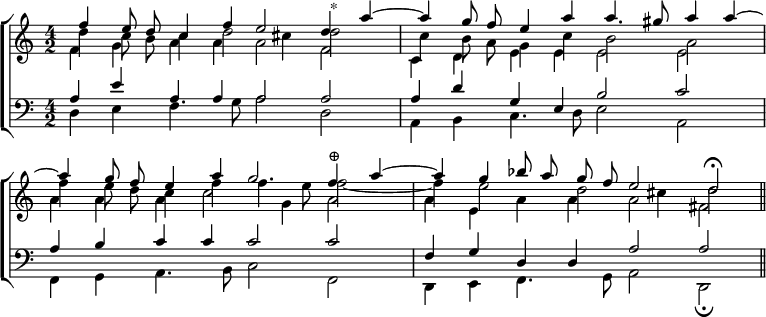subject, Interval for Interval. In Tonal Fugue, the Tonic is always answered by the Dominant, and vice versa. In both, the Imitation is usually conducted, either in the Fifth above the Proposta, or the Fourth below it, when the Subject begins upon the Tonic; and, in the Fourth above, or the Fifth below, when it begins upon the Dominant. [See Fugue, Real Fugue, Tonal Fugue, Subject.]
[ W. S. R. ]
RITARDANDO; RITENENTE; RITENUTO. [See Rallentando.]
RITORNELLO (Abbrev. Ritornel, Ritor.; Fr. Ritournelle). I. An Italian word, literally signifying, a little return, or repetition; but more frequently applied, in a conventional sense, (1) to a short Instrumental Melody, played between the Scenes of an Opera, or even during their action, either for the purpose of enforcing some particular dramatic effect, or of amusing the audience during the time occupied in the preparation of some elaborate 'Set-Scene'; or, (2) to the symphonies introduced between the vocal phrases of a Song, or Anthem.
1. The earliest known use of the term, in its first sense, is to be found in Peri's 'Euridice,' in connexion with a melody for 3 flutes, which, though called a 'Zinfonia' on its first appearance, is afterwards repeated under the title of 'Ritornello.' 'Euridice' was first printed at Florence in 1600, and at Venice in 1608. [For the Zinfonia, see vol. ii. of this Dictionary, p. 499.]
A similar use of the term occurs soon afterwards in Monteverde's 'Orfeo,' printed at Venice in 1609, and republished in 1615. In this work, the Overture—there called Toccata—is followed by a 'Ritornello' in 5 parts, the rhythmic form of which is immeasurably in advance of the age in which it was produced.

* At this mark, the two upper Parts cross, and remain Inverted, until the sign ⊕.
2. When Vocal Music with Instrumental Accompaniment became more extensively cultivated, the word was brought into common use, in its second sense, as applied to the Instrumental Symphonies of a Song, or other Composition for a Solo Voice. Ritornelli of this kind were freely used by Cavalli, Cesti, Carissimi, and many other Composers of the early Venetian Dramatic School, who imitated their manner. An example from Cavalli's 'Il Giasone,' will be found at page 503 of our second volume. Towards the close of the 17th century such instrumental interpolations became very common, in all styles and countries. For instance, in early editions of the Verse Anthems of Croft, Greene, and other English Composers, of the 17th and 18th centuries, we constantly find the words 'Ritornel.', 'Ritor.', or 'Rit.', printed over little Interludes, which, unknown in the more severe kind of Ecclesiastical Music, formed a marked feature in works of this particular School, frequently embodying some of its choicest scraps of Melody, as in Dr. Boyce's Anthem, 'The Heavens declare the glory of God':—

In later editions the term disappears, its place being supplied, in the same passages, by the words 'Organ,' or 'Sym.'; which last abbreviation is almost invariably found in old copies of Handel's Songs, and other similar Music, in which the Symphonies are interpolated, as often as opportunity permits, upon the line allotted to the Voice.
II. An antient form of Italian Verse, in which each Strophe consists of three lines, the first and third of which rhyme with each other, after the manner of the Terza rima of Dante. Little Folk-Songs of this character are still popular, under the name of 'Ritornelli' or 'Stornelli,' among the peasants of the Abruzzi and other mountain regions of Italy.
[ W. S. R. ]
RITTER, Frederic Louis, born at Strasburg, 1834. His paternal ancestors were Spanish, and the family name was originally Caballero. His musical studies were begun at an early age under Hauser and Schletterer, and continued at Paris (whither he was sent when 16 years of age) under the supervision of his cousin, Georges Kastner. Possessed with the idea that beyond the Rhine he would find better opportunities for the study of composition, he ran away to Germany, where he remained for two years, assiduously pursuing his studies with eminent musicians, and attending concerts whenever good music could be heard. Returning to Lorraine, aged 18, he was nominated professor of music in the Protestant seminary of Fénéstrange, and invited to conduct a Société de
